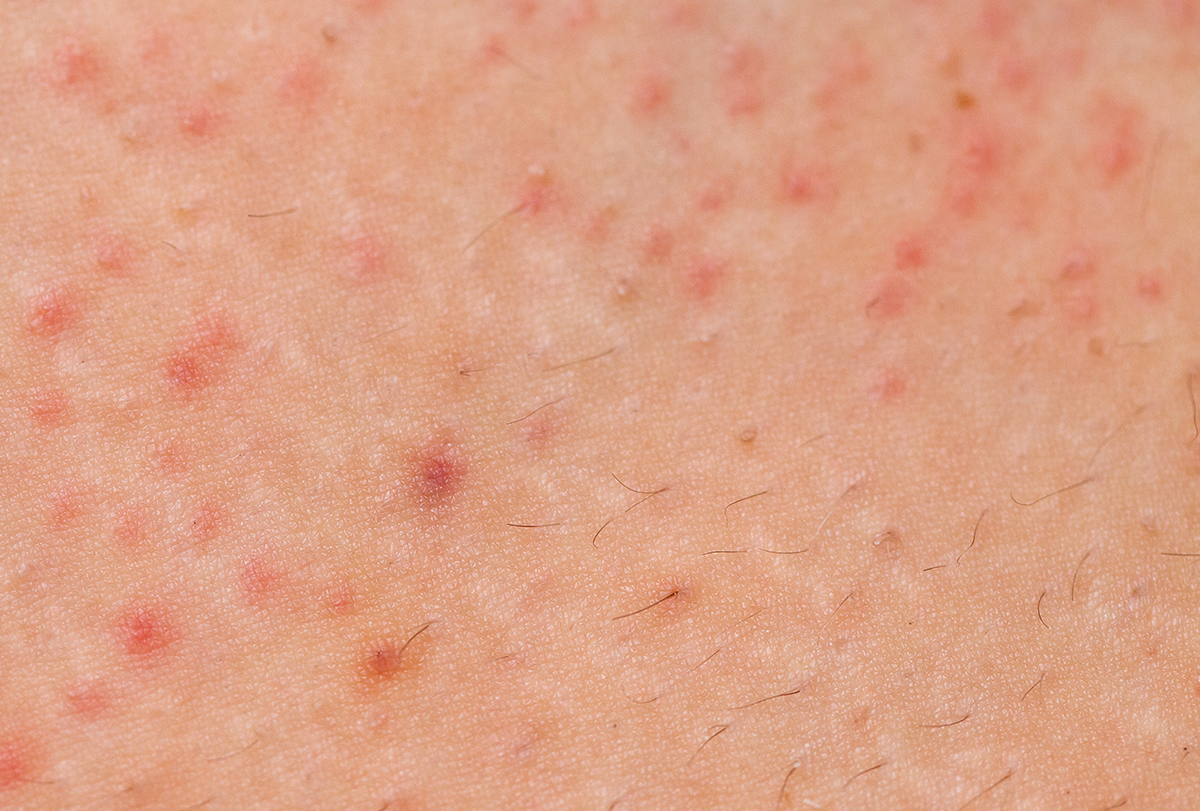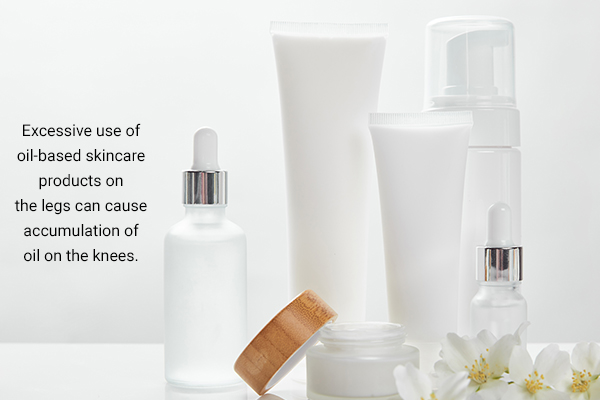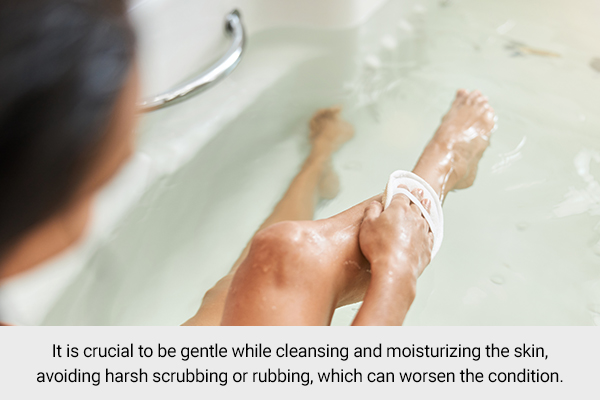In this article:
Pimples are lesions that can occur on any part of the body. Pimples on the knees can be a source of extreme discomfort and pain.

Your knee joint is the largest joint in the body and is also used a lot thoroughly throughout the day.
Your knees are involved in walking, running, jogging, sitting, and changing your posture. Having a pimple on your knees will make all of these things very painful and extremely difficult to do.
Take a look into pimples on the knees in a little more detail.
Causes of Pimples on the Knees
Usually, pimples arise due to some kind of irritation. They are also commonly observed in places where there is a buildup of sebum or oil clogging the pores of your skin. Sometimes, dead skin is also responsible for clogging the pores and causing the formation of pimples.
Although pimples are most commonly seen on your face, back, and chest, a buildup of oil anywhere can lead to pimples. (1)
Here are some common causes of having pimples on the knees.
1. Shaving too much
When a person shaves their legs and knees too much, it may irritate the skin a little bit because of the involvement of hair follicles in these areas. This irritation can further lead to the development of pimples on the knees or in the surrounding areas. (2)
2. Skin care products

Excessively using oil-based skin care products to moisturize the legs can result in the accumulation of oil on the knees. This can cause clogging of the pores, which leads to the formation of pimples on the knees. (3)
3. Sweating from exercises
Oil is a component of sweat; therefore, sweating excessively can contribute to oil buildup, which will clog the pores and cause pimples.
You can have excessive sweating on the knees due to exercising or other such activities. (4)
4. Clothing that is too tight
If you wear clothes that are very tight such as leggings, sweat gets trapped in the clothing and can irritate your skin. Tight clothing can also cause trapping of oil, which can then lead to an oil buildup and, thus, pimples. (5)
5. Unhealthy diet
Many studies have looked into the link between diet and acne. It has been found that:
- Consuming high amounts of sugar and dairy products can increase the risk of acne. Drinking sugary drinks such as sodas, sweetened tea, and fruit-flavored drinks and eating dark chocolate every day have been associated with acne.
- Eating a high-glycemic-load diet can also lead to acne. Such a diet causes the body to secrete large amounts of insulin, which can increase androgen levels and promote sebum secretion, leading to the development of acne.
- There is a positive association between acne and the consumption of whole milk and skim milk, which can also increase the levels of insulin-like growth factors.
- Greasy and fatty foods can contribute to acne because they release free fatty acids that promote the development of acne. (6)
Management of Pimples on the Knees
Pimples on the knees can be resolved by implementing these measures.
1. Use the right skin care products

To prevent pimples on your knees, avoid overwashing your skin multiple times a day, as this can dry it out and make it more irritated. Try these skin care practices and products instead:
- Use oil-in-water emulsions or moisturizing gels, such as hydrogels, as they are less likely to clog pores.
- Regular soap with a high pH level can irritate the skin, so it’s better to use soap-free cleansing products with a pH level similar to that of the skin (around 5.5), which are more suitable for people with acne-prone skin. (7)
- Be careful when selecting skin care products, and opt for noncomedogenic cosmetics, which do not promote the formation of comedones (lesions caused by the accumulation of keratin and sebum in hair follicles).
- Products containing comedogenic hydrocarbons such as petrolatum and paraffin should be avoided.
- Use washing fluids that contain benzoyl peroxide, as they exhibit strong antibacterial properties and help to control the pathogenic flora of the skin. (8)
2. Bathe after exercising
The development and severity of acne are influenced by various factors, including genetics, stress, androgens, and even excessive sweating. (9)
So, to prevent the formation of pimples on the knees due to excess sweating, it is crucial to take a shower or bath after engaging in physical activity or anything that causes profuse sweating.
To manage acne, use gentle skin cleansers that effectively remove excess sebum and exfoliate the skin while reducing the secretion of sweat glands.
Ideal options include micellar fluids, gel preparations, and soaps with an acidic pH ranging from 5.0 to 7.0. This approach helps to prevent the exacerbation of acne caused by sweat and excessive oil buildup. (8)
3. Be gentle on your skin

Acne-prone skin is highly susceptible to irritation, and aggressive washing and scrubbing can exacerbate the inflammation associated with acne.
Therefore, be gentle when cleansing and moisturizing your skin, avoiding harsh scrubbing or rubbing, which can worsen the condition. A mild, nonabrasive cleanser should be used for daily cleansing. (8)
4. Avoid unhealthy foods
To prevent acne, it is important to avoid unhealthy foods.
One study found that greasy food, spicy food, dairy products, and sweets are all risk factors for acne. This means that reducing or eliminating these types of foods from your diet could help to prevent or reduce the severity of acne. (6)
5. Do not wear very tight clothes
As discussed above, tight clothes can cause trapping of oil and sweat, which may lead to the development of pimples. So, it is best that you wear clothes that are either a bit loose or are not too tight for you. (5)
6. Protect yourself from the sun
According to a survey, sun exposure played a significant role in the incidence of acne. A survey of people with acne in India showed that 26.4% of them developed skin lesions after exposure to sunlight and 44.5% of patients experienced worsening of skin symptoms in the month of summer due to extreme sun exposure. (6)
Researchers also found acne was significantly more frequent in individuals with moderate or intensive sun exposure due to their work or daily activities. (6)
To protect your knees from the sun and prevent acne, it is important to avoid prolonged sun exposure and to use sunscreen with a minimum SPF of 30.
Wearing protective clothing such as long pants or leggings can also provide an extra layer of protection. If you need to be outside for extended periods, seek shade and take breaks indoors to avoid excessive sun exposure.
Difference Between Face Pimples and Knee Pimples?
The main difference between face pimples and knee pimples is the location on the body where they occur. Face pimples typically occur on the face, whereas knee pimples occur on or around the knees.
In addition, knee pimples can be caused by a variety of factors including friction and tight clothing, which may not apply to the face. Treatment and prevention methods may also differ, as the skin on the face and knees may have different sensitivities and require different care.
It is important to consult a dermatologist for personalized advice on how to treat and prevent pimples in different areas of the body.
Most-Asked Questions About Knee Pimples
How do I know that I have a pimple on my knee and not a cyst?

It is possible that what may appear as a pimple to you may actually end up being a cyst.
Cysts grow very slowly and do not have a white covering as pimples do. Cysts are also foul smelling and can sometimes be very large and painful.
Although pimples resolve themselves quickly within a few days, cysts may require draining by a medical professional. (10)
My child has pimples on her elbows, knees, and feet. What should I do?
Having pimples on your elbows, knees, and feet is usually a sign of a viral infection that will resolve by itself in a week or two. No treatment is required in such cases.
There may also be rashes and some itching, for which you can apply calamine lotion or coconut oil to the affected area to provide the child with some symptomatic relief.
If you think that the condition is not getting better even after a few days, then you should seek medical help.
Can keratosis pilaris cause acne on the knees?
Keratosis pilaris is a skin condition that often occurs in teenagers. It causes small, raised bumps with redness around hair follicles on the lower limbs, which include the knees. (11)
Research found that people with keratosis pilaris have a lower risk of getting acne and less severe acne when compared to those without the condition.
The reason for this is not completely clear, but it could be due to lower sebum production or a different way that skin cells develop in people with keratosis pilaris. However, the study has some limitations such as small sample size and possible biases.
Overall, having moderate to severe keratosis pilaris on the upper limbs may be associated with a lower risk of acne and less severe acne. (12)
Final Word
Pimples on the knees can be a source of discomfort and pain and can disrupt daily activities that involve movement of the knee joint. Pimples on the knees can be a result of various factors such as shaving, use of oil-based skin care products, sweating from exercises, wearing tight clothing, and unhealthy diet.
Effective management of pimples on the knees involves using the right skin care products, bathing after exercising, being gentle on the skin, and avoiding unhealthy food.
A good skin hygiene routine, including using gentle skin cleansers, avoiding harsh scrubbing, and washing with fluids that contain benzoyl peroxide, can help prevent and manage pimples on the knees.
- Was this article helpful?
- YES, THANKS!NOT REALLY


